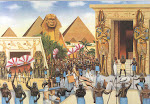Previously archeologists believed that the transition between Predynastic and Dynastic was the result of a brutal series of revolutions and warfare resulting from the discovery of metallurgy and the new social structures such as cities, individual dwellings, and writing. Yet as more and more details of this period emerged, we see that it was nothing of the sort, but rather the slow process of technological evolution.
The Predynastic period is comprised of three distinct staged of development.
Chalcolithic (5,500 BC)
AKA the "Primitive" Predynastic, marks the beginning of the true Predynastic cultures. For the most part the south, especially the Baldarian, practiced an agraian culture while the north depended heavily on hunting and fishing.
Amratian (4,500 BC)
This period is marked by true architecture, individual dwellings, towns and even "urban planning." The Kemetian artist also came into his own with beautiful geometric shapes in paintings and carvings and the well known dancing figurines of women with upraided arms.
Gerzean (4,000 BC)
Although the Amratian period is often designated Naqada I while the Gerzean period is often designated Naqada Ii these are two distinct cultures. During the Gerzean period the north begins to have a great ingluence on the south creating a mingling between the two. Gerzean artistry also evinces that they were familiar with subsesert animals such as the ostrich and the Ibexes which were not found in the Nile region. We also began to see the first depictions of mythological imagery . Most of these mythological images are shown riding in boats and carrying standards very much like the standards later used to represent Kemetian provinces.
Thursday, 30 April 2009
Subscribe to:
Post Comments (Atom)






No comments:
Post a Comment